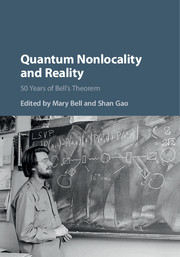Book contents
- Frontmatter
- Contents
- Contributors
- Preface
- Preface
- Part I John Stewart Bell: The Physicist
- Part II Bell's Theorem
- Part III Nonlocality: Illusion or Reality?
- Part IV Nonlocal Realistic Theories
- 19 Local Beables and the Foundations of Physics
- 20 John Bell's Varying Interpretations of Quantum Mechanics: Memories and Comments
- 21 Some Personal Reflections on Quantum Nonlocality and the Contributions of John Bell
- 22 Bell on Bohm
- 23 Interactions and Inequality
- 24 Gravitation and the Noise Needed in Objective Reduction Models
- 25 Towards an Objective Physics of Bell Nonlocality: Palatial Twistor Theory
- 26 Measurement and Macroscopicity: Overcoming Conceptual Imprecision in Quantum Measurement Theory
- Index
- References
20 - John Bell's Varying Interpretations of Quantum Mechanics: Memories and Comments
from Part IV - Nonlocal Realistic Theories
Published online by Cambridge University Press: 05 September 2016
- Frontmatter
- Contents
- Contributors
- Preface
- Preface
- Part I John Stewart Bell: The Physicist
- Part II Bell's Theorem
- Part III Nonlocality: Illusion or Reality?
- Part IV Nonlocal Realistic Theories
- 19 Local Beables and the Foundations of Physics
- 20 John Bell's Varying Interpretations of Quantum Mechanics: Memories and Comments
- 21 Some Personal Reflections on Quantum Nonlocality and the Contributions of John Bell
- 22 Bell on Bohm
- 23 Interactions and Inequality
- 24 Gravitation and the Noise Needed in Objective Reduction Models
- 25 Towards an Objective Physics of Bell Nonlocality: Palatial Twistor Theory
- 26 Measurement and Macroscopicity: Overcoming Conceptual Imprecision in Quantum Measurement Theory
- Index
- References
Summary
Abstract
Various interpretations of quantum mechanics, favored (or neglected) by John Bell in the context of his nonlocality theorem, are compared and discussed.
Varenna 1970
I met John Bell for the first time at the Varenna conference of 1970 [1]. I had been invited on the suggestion of Eugene P. Wigner, who had already helped me to publish my first paper on the concept that was later called decoherence – to appear in the first issue of Foundations of Physics a few months after the conference [2]. This concept arose from my conviction, based on many applications of quantum mechanics to composite systems under various conditions, that Schrödinger's wave function in configuration space, or more generally the superposition principle, is universally valid and applicable. In particular, stable narrow wavepackets can represent classical configurations, while their superpositions define novel individual properties – such as “momentum,” defined as a plane wave superposition of different positions. Superpositions of macroscopically different properties, on the other hand, are regularly irreversibly “dislocalized” (distributed over many degrees of freedom) by means of interactions described by the Schrödinger equation. The corresponding disappearance of certain local superpositions (“decoherence”) seems to explain the phenomenon of a classical world as well as the apparent occurrence of quantum jumps or stochastic “events” – see Sect. 20.4 or [3] for a historical overview of the conceptual development of quantum theory. So I had never felt any motivation to think of “hidden variables” or any other physics behind the successful wave function.
Therefore, I was very surprised on my arrival in Varenna to hear everybody discuss Bell's inequality. It had been published a few years before the conference, but I had either not noticed it or not regarded it as particularly remarkable until then. As this inequality demonstrates that the predictions of quantum theory would require any conceivable reality possibly underlying the nonlocal wave function to be nonlocal itself, I simply found my conviction that the latter describes individual reality confirmed. For example, I had often discussed the conservation of total spin or angular momentum in an individual decay process, which requires nonlocal entanglement between the fragments at any distance in a form that was later called a “Bell state”.
Information
- Type
- Chapter
- Information
- Quantum Nonlocality and Reality50 Years of Bell's Theorem, pp. 331 - 343Publisher: Cambridge University PressPrint publication year: 2016
References
Accessibility standard: Unknown
Why this information is here
This section outlines the accessibility features of this content - including support for screen readers, full keyboard navigation and high-contrast display options. This may not be relevant for you.Accessibility Information
- 1
- Cited by
